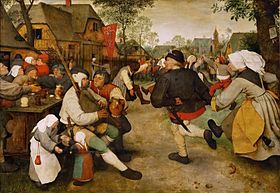
Back Genremalerei ALS رسم نوعي Arabic Janr rəssamlığı Azerbaijani Жанравы жывапіс Byelorussian Битова живопис Bulgarian Pintura de gènere Catalan Žánrové umění Czech Genrebillede Danish Genremalerei German Ρωπογραφία Greek

Genre painting (or petit genre), a form of genre art, depicts aspects of everyday life by portraying ordinary people engaged in common activities.[1] One common definition of a genre scene is that it shows figures to whom no identity can be attached either individually or collectively, thus distinguishing it from history paintings (also called grand genre) and portraits. A work would often be considered as a genre work even if it could be shown that the artist had used a known person—a member of his family, say—as a model. In this case it would depend on whether the work was likely to have been intended by the artist to be perceived as a portrait—sometimes a subjective question. The depictions can be realistic, imagined, or romanticized by the artist. Because of their familiar and frequently sentimental subject matter, genre paintings have often proven popular with the bourgeoisie, or middle class.
Genre subjects appear in many traditions of art. Painted decorations in ancient Egyptian tombs often depict banquets, recreation, and agrarian scenes, and Peiraikos is mentioned by Pliny the Elder as a Hellenistic panel painter of "low" subjects, such as survive in mosaic versions and provincial wall-paintings at Pompeii: "barbers' shops, cobblers' stalls, asses, eatables and similar subjects".[2] Medieval illuminated manuscripts often illustrated scenes of everyday peasant life, especially in the Labours of the Months in the calendar section of books of hours, most famously the Très Riches Heures du Duc de Berry.

- ^ Art & Architecture Thesaurus, s.v. "genre" Archived 2018-07-31 at the Wayback Machine. Accessed 30 April 2022.
- ^ Book XXXV.112 of Natural History.
© MMXXIII Rich X Search. We shall prevail. All rights reserved. Rich X Search